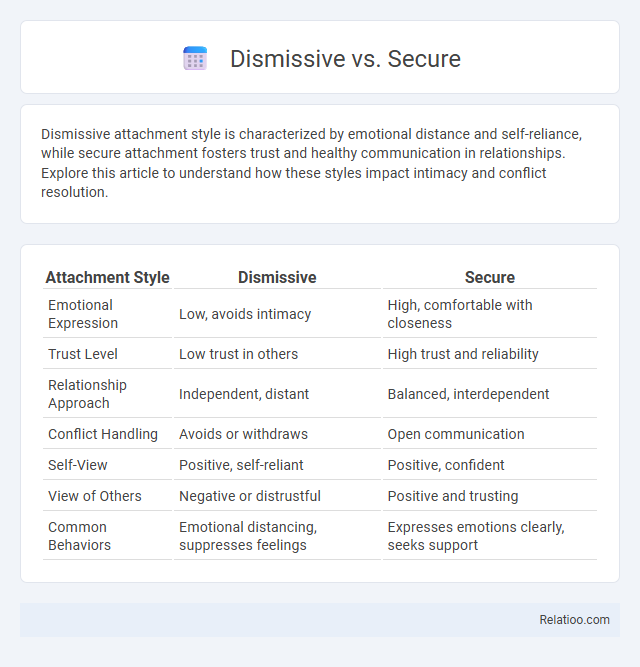Dismissive attachment style is characterized by emotional distance and self-reliance, while secure attachment fosters trust and healthy communication in relationships. Explore this article to understand how these styles impact intimacy and conflict resolution.
Table of Comparison
| Attachment Style | Dismissive | Secure |
|---|---|---|
| Emotional Expression | Low, avoids intimacy | High, comfortable with closeness |
| Trust Level | Low trust in others | High trust and reliability |
| Relationship Approach | Independent, distant | Balanced, interdependent |
| Conflict Handling | Avoids or withdraws | Open communication |
| Self-View | Positive, self-reliant | Positive, confident |
| View of Others | Negative or distrustful | Positive and trusting |
| Common Behaviors | Emotional distancing, suppresses feelings | Expresses emotions clearly, seeks support |
Understanding Attachment Styles: Dismissive vs Secure
Understanding attachment styles reveals that dismissive individuals often maintain emotional distance and prioritize independence, exhibiting a tendency to downplay the importance of close relationships. In contrast, secure attachment is characterized by a balance of intimacy and autonomy, where individuals comfortably engage in close relationships while retaining self-reliance. Recognizing these differences is crucial for improving interpersonal dynamics and fostering healthier emotional connections.
Key Characteristics of Dismissive Attachment
Dismissive attachment is characterized by a strong desire for independence, emotional distance, and reluctance to depend on others, often resulting in suppression of feelings and avoidance of intimacy. Individuals with dismissive attachment tend to downplay the importance of relationships, exhibit self-reliance, and resist vulnerability. This contrasts with secure attachment, which involves comfort with closeness and trust, and anxious attachment, marked by fear of abandonment and heightened emotional needs.
Defining Traits of Secure Attachment
Secure attachment is characterized by trust, emotional openness, and a healthy balance of independence and closeness in relationships. Individuals with secure attachment easily communicate their feelings and seek support when needed, fostering strong interpersonal connections. You can recognize secure attachment by its consistent ability to maintain intimacy without fear of abandonment or excessive dependence.
Emotional Patterns: How Dismissive and Secure Differ
Dismissive attachment patterns exhibit emotional distancing and avoidance of intimacy, often leading to suppressed feelings and reluctance to rely on others, while secure attachment fosters openness, trust, and healthy emotional expression. You experience emotional availability and comfort with vulnerability in secure patterns, contrasting sharply with the emotional self-sufficiency and defensiveness seen in dismissive styles. Understanding these differences helps improve your relational dynamics by promoting empathy and authentic connection.
Communication Styles in Dismissive and Secure Individuals
Dismissive individuals typically exhibit communication styles characterized by emotional distance, minimal self-disclosure, and a tendency to avoid vulnerability, often leading to brief, guarded interactions. Secure individuals display open, honest communication with balanced self-disclosure and active listening, fostering trust and emotional connection. Understanding these contrasting styles in dismissive and secure individuals highlights how attachment patterns influence interpersonal communication dynamics.
Relationship Behaviors: Dismissive vs Secure Partners
Dismissive partners often exhibit emotional distance and reluctance to depend on others, leading to challenges in intimacy and trust within relationships. Secure partners demonstrate consistent responsiveness, open communication, and emotional availability, fostering trust and deeper connection. These contrasting behaviors significantly impact relationship satisfaction and stability, as secure partners promote mutual support while dismissive partners may create emotional barriers.
Impact on Conflict Resolution
Dismissive attachment styles often hinder conflict resolution by avoiding emotional engagement, leading to unresolved issues and communication breakdowns. Secure attachment promotes openly expressing feelings and active listening, facilitating effective problem-solving and mutual understanding during conflicts. In contrast, anxious attachment may escalate conflicts due to fear of abandonment, resulting in intensified emotional reactions and difficulty reaching consensus.
Childhood Origins of Dismissive and Secure Attachment
Dismissive attachment often originates from childhood experiences where caregivers are emotionally unavailable or unresponsive, leading children to suppress their need for closeness and prioritize independence. In contrast, secure attachment develops through consistent, sensitive caregiving that fosters trust and emotional safety, enabling children to confidently seek support and explore their environment. Understanding these distinct childhood origins is crucial for recognizing how early interactions shape adult relational patterns and emotional regulation.
Transitioning from Dismissive to Secure Attachment
Transitioning from dismissive to secure attachment involves cultivating emotional awareness and developing trust in close relationships. Engaging in consistent, supportive interactions helps individuals overcome avoidance and build healthier, more connected bonds. Therapeutic approaches, such as cognitive-behavioral therapy or attachment-based therapy, effectively support this transformation by addressing underlying fears of intimacy and promoting emotional regulation.
Strategies for Nurturing Secure Attachment in Relationships
Understanding the differences between dismissive, secure, and anxious attachment styles can help you develop effective strategies for nurturing secure attachment in relationships. Prioritize consistent communication, emotional availability, and empathy to build trust and safety, which counteracts dismissive tendencies and reduces anxiety. Encouraging openness and vulnerability allows both partners to feel valued and supported, fostering a stronger, secure connection.

Infographic: Dismissive vs Secure
 relatioo.com
relatioo.com